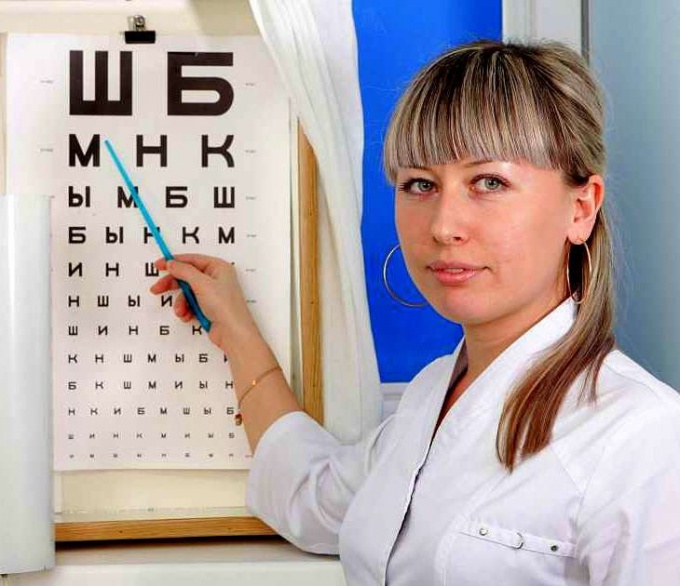Instruction
1
Vision screening begins with an external examination of the ocular apparatus. Optometrist (more modern title of specialist in eye diseases ophthalmologist) determines the state of the eyelids, cornea, iris, pupil, etc.
2
Then we will examine the sharpness of distance vision. Doctors traditionally use the table Sivtseva. It either hangs on the wall or projected on a white screen. This table consists of 12 lines of different letters from large to very small. Twenty feet from her chair. You offer to sit, and to call specified doctor of letters: large, then smaller and smaller.
3
First check the visual acuity of the right eye while you close the manual shutter of the left eye. Then Vice versa. Every line is 10% visual acuity.
4
If you clearly see the letter of the tenth line from the top – you have full vision (of 1.0 unit). The eleventh and twelfth lines are usually well distinguished, characterized by farsightedness.
5
If you see less than ten rows, then the doctor selects or glasses or contact lenses. He wears you to the spectacle frame with grooves, which alternately inserts a few lenses.
6
The degree of vision correction with their help determined by reading the rows of the table Sivtseva. From the several options you choose the one that produces the maximum number of clearly visible lines.
7
It is important to avoid discomfort from prescribed lenses. If the eyes are "cut", they are watering, the picture "ghosting", or you have a headache, slight dizziness, tell certainly. The doctor will choose the lens with less diopters. Glasses should always be a little "weaker".
8
Children who cannot read, vision is tested or on the table Golovin, which depicts the decreasing rings with slits in different directions, or the grid Orlova pictures. On them and choose either glasses or contact lenses.
9
Near vision ophthalmologist checks, offering to read short texts on the card, which also differ in the size of the font. To read these lines should be holding the card in front of him at a distance of 35 cm.
10
If the vision is very weak and the patient will not even see a huge letter of the first line "sh" and "B", the optometrist determines the visual acuity on the fingers. He shows the patient a different number of fingers on your hand, gradually moving away from him. And the result determines the distance from itself to the patient.
11
Modern eye clinic is equipped with electronic optical devices which determine the visual acuity instantly, and not empirically, by tables, and automatically. To deceive them is absolutely impossible.
12
There are people for which, for example, red and green are one and the same. Correct vision optometrist determines the Atlas with colored optical tests. They consist of dots and circles, out of which only "lurking" numbers or geometric shapes. The doctor offers to call them. If the patient sees them or sees other figures and shapes, then he is colorblind.
13
It is very important to also check the fundus. The doctor digs in both eye drops, pupils are soon greatly enlarged, and he well illustrated the condition of the retina, blood vessels, macula.
14
Equally important indicators such as intraocular pressure. If it increased, developing glaucoma. Modern automatic device pneumotonometer goes to the eyes exhaust, and the pressure is measured instantaneously. The norm is 15-16 mm Hg. article
15
And the old fashioned way, intraocular pressure is measured by tonography small cylinder, the bottom of which is painted with a special paint. Monograph is placed on the eyeball, pre-treated mild analgesic drops. The imprint is transferred onto paper in the form of a circle, then its diameter is measured with a ruler. The norm – up to 24 mm Hg. article
Note
If there is pain, "floaters" or the fiery circles in the eyes, the outlines of objects seen vaguely painful to look at light, immediately contact the optometrist. Sometimes for the salvation of man from blindness every hour is crucial!
Useful advice
Special preparation for examinations is not necessary. But you should know that sleepy state, fatigue, alcohol, adopted in a day or two before, may affect the objectivity of the results. Also, before it is advisable to take any medication.
